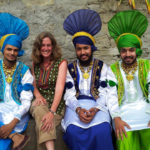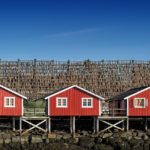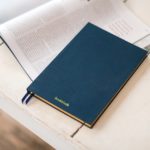Abandoned California: In Conversation with Joanna Kalafatis

Abandoned California: In Conversation with Joanna Kalafatis
Abandoned Southern California, The Eras that Shaped the West by Joanna Kalafatis pays homage to abandoned, neglected and reclaimed towns, communities and buildings in and around Los Angeles County. The book is no less a tribute to the people who came to this part of California to find a better life. Whether the landscape is desert, coastal or inner-city, Abandoned Southern California conveys respect for the harsh environments and socioeconomic conditions that exist alongside the glamor that is often associated with Southern California.
The author, Joanna Kalafatis, is a photographer, travel writer and actress. Her book is built around photos that reflect her love of exploration and historic places. The text that accompanies her photos helps tell the stories of old desert mining communities; of the rise and fall of the railroad and Route 66; of abandoned hospitals and a jail; and of a town that fell into the sea. All have become victim to various pairings of extreme temperatures, drought, floods, fierce winds, human neglect and progress.
All have become victim to various pairings of extreme temperatures, drought, floods, fierce winds, human neglect and progress.
Some places are evocative for their names (Home for the Ill and the Poor in Rancho Los Amigos); some for practices that were abandoned with the building (lobotomies were once performed at Camarillo State Mental Hospital); and some for the hope of a better future that still drives people to Southern California (Slab City – The Last Free Place in America).

Many of the mid to long-shot photographs included in Abandoned Southern California are bleak and lonely, aptly depicting what’s become ruined in forsaken, austere, desolate environments. Some signs still hanging inside doors, or on the sides of deserted buildings, are just a little too far away to make out what they say.
Close-up photos of an old bathtub, laundry appliances and a stove in Calico, the ‘tourist ghost town’, give a glimpse into the hardships of domestic life of the early 1900s. A peek inside a small abandoned cage at the old Griffith Park Zoo in LA made me shudder.
While the locations in the book are interesting in and of themselves, there were times when I wanted a map to give me an overview of their whereabouts. I don’t mean a “here-is-how-to-get-there” map, but more a bird’s-eye view of the area explored and where the sites exist in relation to one another (and, I suppose, in relation to where I live, on the boundary of Southern California).
Joanna says that creating this book has been one of the most rewarding experiences of her life, and I had the pleasure of speaking with her about it.
How did you become an explorer of abandoned places?
I fell in love with exploring as a child in Greece. Young and bored, in a country full of ruins from the distant past, I began to explore old, abandoned houses in towns where I visited relatives with my parents. Homes were left empty during a period of rapid urbanization, when many people moved to the cities. It was a snapshot into everyday people in another time. By the time I came to California I was already steeped in stories of the old West and I became obsessed with California history.
What do abandoned places mean to you?
They show how people lived at certain times, in certain places. It’s a recent form of archeology, a way to see history come alive.
What are some memorable experiences you had when exploring abandoned places?
Oh, so many, some frightening. Abandoned places can be dicey to explore. They’re attractive to squatters, drug users, other illicit activity. Some towns are 90% abandoned, but sometimes people are there, sometimes hiding in the shadows.
Once, outside Randsburg in the silver mining district, I was setting up a shot outside a building that looked totally dilapidated. I was looking through my lens, getting ready to take a photo through a door and saw and old woman staring back at me. I jumped back.
In fact, don’t always understand what I’m seeing. Inside one hospital where the power was out, there was a back room where fans were spinning, lights were on, and desks were turned on their sides. I got out fast! In another hospital, I found a man’s club membership card on the ground. It looked brand new, but the date on the card was 1957. I’m not personally a believer in ghosts but there was something definitely mystifying about this experience.

Are there any abandoned places in Southern California that you didn’t include in the book?
There were places I couldn’t get into. For example, there are some locations that have become popular for film making and security is tight. I looked into getting a half-day permit to shoot a few photos at Hawthorne Plaza Mall and was told I could do that for $12,000. I didn’t get any photos in that case!
Are there any places you haven’t gone yet that you’d like to?
I only recently heard about Rockhaven Sanatarium in Glendale and found out that the local historical society does tours. I’d like to go there.
There’s also Murphy Ranch near Thousand Oaks. It was originally a ranch and there are some good hiking trails on the property. The ranch was recently used as base for a neo-Nazi cult and it was shut down somewhat violently.
I’d love to visit Chernobyl. It’s not just a ghost town but a whole city that was abandoned.
Was there any place in particular that affected you more than the others?
For me, Bodie (which I researched for my Abandoned Northern California book) was definitely the most affecting. Because I had grown up fascinated by the old West, cowboys, and life back then, seeing this town preserved in a state of arrested decay from that era, with houses and buildings full of furniture, clothing, portraits, and other items, was absolutely fascinating.
How did you select the photos that you used?
Sometimes I chose them for their technical standards, for example their clarity, or the play of light in them. Other times, the choice was more instinctive. Out of three or four photos that I might have of the same location, one might jump out at me – not because it’s technically the best but because it gives the best sense of the place, or how I felt being there.
Most of the photos you included are medium to long shots, a few are closer up; would you say this is reflective of your photo style, of the abandoned places themselves, or something else?
The photos are reflective of the way I explore a place and the way I try to tell a story. I want to establish the environment first, to create a sense of location. Close-ups of particular things aren’t meaningful without that context.
In the book’s acknowledgments you say “Creating this book has been one of the most rewarding experiences in my life”. Please tell me some more about that.
I was approached by the publisher of the book series (America Through Time) right after a pop-up gallery show I did in LA. Not only was this my first ever photo book, it was about things I love – abandoned places and California, my adopted state. While researching the book, I got to go to places I hadn’t yet visited and found out things I hadn’t known.
For example, I learned while visiting the old ghost town of Calico that a lot of cowboys were immigrants from other countries (China, Greece, England, France, Ireland) and not like the all-American cowboy we see in the movies. The West, like the rest of the United States, was built by so many different people.
What’s important for people to know about you that didn’t fit on the inside back cover of the book?
I’m originally from Greece. Going back and forth between two places, two cultures got me interested in travel writing and photography. The curiosity and openness that I bring to travel is what’s important.
Travel in itself doesn’t necessarily make you open-minded; you have to bring that to travel in order to learn about other people, other cultures. You can travel and stay isolated in a big hotel, never learning anything new. Even if you can’t travel for whatever reason, you can learn about places that interest you on the internet if you have a curiosity about the world.
There was a lot of serendipity in you being approached by a publisher for your first book. Do you have any thoughts for Pink Pangea readers about how to find a publisher?
Companies like Fonthill Media (publisher of Abandoned Southern California) are open to novices. They publish photo books. I was approached because they were already doing a series on abandoned places in the US and I had already done some exploring and photos of California. You can pitch to them. Include the proposed title and a brief description of the book, the proposed word count, the nature and number of illustrations, and a brief description of yourself.
You can approach small publishers. Go to events where you can meet people. It’s always best if you can meet someone in person before pitching. Your email is more likely to stand out to them if they’ve met you first.
What’s next for you?
I can’t say too much about this yet, but I’m working on an idea for a television travel show series. I have experience both acting and hosting shows so it would be an expansion on things I’ve already done.
In Conversation with Joanna Kalafatis top image: Randsburg, California. Photo by Joanna Kalafatis








